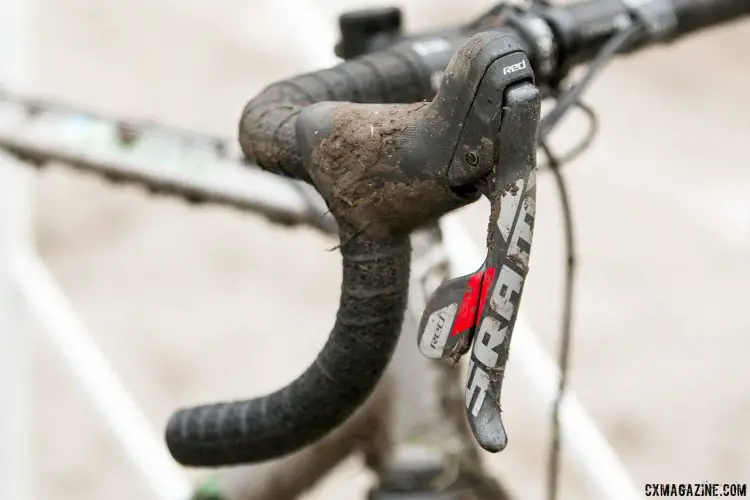
As seen with Gage Hecht’s National-winning bike, shifters have to be well-maintained to handle the beating of cyclocross. © Cyclocross Magazine
Many of us are familiar with the need to maintain our drivetrains. After all, a chain and gear open to the elements rarely conceals the havoc that cyclocross mud and the grit of gravel grinders wrecks on our components (one of the many examples can be seen with Dex Downey’s Singlespeed bike he used in an attempt to tackle the 2015 Lost and Found Gravel Race.) Shifters, on the other hand, can often go overlooked, getting no more attention than a light cleaning of the hoods. The results can mean sluggish shifting or even worse.
As this year’s Dirty Kanza 200 proved, a cyclocross bike can be exposed to plenty of muddy conditions in the off-season, although dry grit can be even more damaging to components. For today’s Mechanical Monday, we resurfaced an important “How To” guide by Drew Hager, detailing the best practices of cleaning and maintaining mechanical shifters.
by Drew Hager
The trick to cleaning shifters (and all of your drivetrain) is to clean it while it’s still wet. Wet mud doesn’t do nearly the damage as dry grit. I get it: we’re tired and maybe had a few beers after the race so we nap on the couch rather than get on our bike maintenance and the next thing we know, the mud is now dry and gritty. Often, folks will just spray some lube in the shifter’s guts to get it moving again and call it good.
But there is a better method. An adequate pressure hose should be enough to blast the gunk out. Simply peel the hood back and flush it, let it dry and re-apply lube. I prefer a thin oil to the grease that the factory installs if you have to constantly clean your shifters. Dumonde Tech sells a great product called Freehub Oil, which is thick for an oil yet still more thin than a grease. It coats well and has great capillary action. And, an added benefit for ’cross, it is rated to -40 degrees before its done being slick. Freehub oil works well for all ratchet and pawl mechanisms besides just freehubs, and it works great on shifter internals. More than anything, dirty oil is slicker than dirty grease and doesn’t cause as much initial damage.
When doing this type of cleaning in the pit, I’d stay away from the pressure washer with your shifter’s internals. I first tried ProGold’s Blast-Off years ago and found it to work with great success. It is a can of high-pressure residue-free cleaner and it un-clogged shifters quick in the worst mud I’ve seen. I have also got on good word from a guy who owns a fleet of neutral service pit bikes that he uses electric parts cleaner to de-gunk his bike’s shifters.
As far as the type of cables you should run, that answer may be dependent on what your style of bike maintenance is. Personally, I am always messing with my bike so I tend to stick with affordable, easily obtained un-coated stainless steel cables and housing with nose ferrules on the last exposed piece of cable. I replace cables as needed, which is usually as soon as I feel friction in the line. I will let a brake cable go untended longer than a shift cable. That said, many folks have great luck with sealed cable set-ups. The installation takes more attention and time, but could last an entire season. My major hold back from a sealed set up is that the system’s weakest point is the first thing you mention, it’s connection to the shifter.
Drew Hager is an employee of Industry Nine, handcrafting fine USA-made wheels. Drew began working in cycling as a teenager and currently holds a cat 2 cyclocross license and a USAC race mechanic license.




























